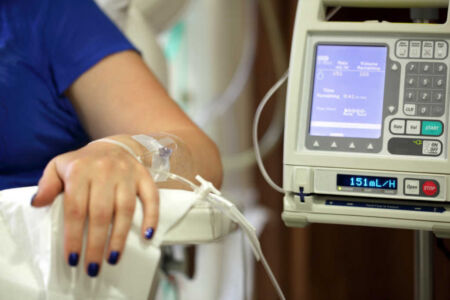
Cancer patients are at greater risk of developing blood clots, but doctors have methods to keep blood flowing properly.
Unfortunately, patients who’ve been diagnosed with cancer are at greater risk than the general population of developing deep vein thrombosis (DVT), especially if they’re diagnosed with lung, liver, or stomach cancer, pancreatic cancer, leukemia, or lymphoma.
There are two main reasons for this: first, cancer cells interfere with the delicate balance of platelets and special proteins that promote clots to stop the body from bleeding too profusely from a wound. This can lead to abnormal or excessive clotting.
Second, chemotherapy drugs, such as tamoxifen for the treatment of breast cancer, can either decrease the amount of blood-clotting proteins or damage veins. In addition, because inactivity raises the potential for DVT, blood clots can form after cancer surgery because a patient lies in bed for an extended period.
It’s vital to be aware of DVT risk, as the condition requires immediate medical attention. It typically develops in the legs, and becomes noticeable when the limb cramps up and swells. If the clot floats from the leg to lungs, it can cause a pulmonary embolism, a potentially life threatening condition.
Before cancer treatment starts, patients will be asked about a personal or family history of blood clots. It’s likely that they will also undergo tests to detect any protein deficiencies that could induce clotting or receive an ultrasound of the leg veins to ensure there are no existing clots.
It’s also important to note that, while DVT is not only a serious condition in and of itself, medical researchers believe it may also put people at greater risk of developing cancer. Past and present DVT patients are therefore urged to go through regular cancer screenings, such as mammograms and colonoscopies.
In an effort to reduce the formation of blood clots in cancer patients, oncologists couple life-saving treatments with a variety of anti-DVT remedies. Blood thinners, or anticoagulants like Heparin, disrupt the catalysts responsible for blood clots. Other drugs, known as thrombolytics, can break up clots that have already formed. Those medications are either given via injection, catheter, or IV.
Those aren’t the only options available. A filter placed in the inferior vena cava — the large vein that moves blood from the legs to the heart — catches bits of clots and prevents them from flowing to the heart or lungs. If those methods fail to block or dissolve a clot, surgery may be necessary to remove it.
While these therapies lower the prospect of DVT, they may also spur bleeding. Because of this risk, medical professionals carefully review how a patient responds to medications and adjust dosages accordingly to ensure patient safety.
Cancer patients are advised to stay as active as possible when they receive treatments and wear compression stockings to ensure maximum blood circulation. In addition, they should avoid sitting for long periods, especially if they are traveling on a plane or in a car, to decrease the chance of getting a blood clot.
Patients concerned about their DVT risk should consult a vein specialist. The medical experts at the Center for Vein Restoration can evaluate your risk of developing DVT and recommend appropriate therapies to prevent or eliminate the clots. Book an appointment today.